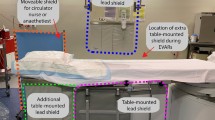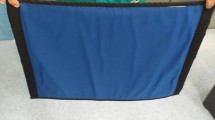Abstract
Purpose
The aim of the study was to evaluate the radiation exposure to operating room personnel and to assess determinants for high personal doses during endovascular aortic repair.
Materials and Methods
Occupational radiation exposure was prospectively evaluated during 22 infra-renal aortic repair procedures (EVAR), 11 thoracic aortic repair procedures (TEVAR), and 11 fenestrated or branched aortic repair procedures (FEVAR). Real-time over-lead dosimeters attached to the left breast pocket measured personal doses for the first operators (FO) and second operators (SO), radiology technicians (RT), scrub nurses (SN), anesthesiologists (AN), and non-sterile nurses (NSN). Besides protective apron and thyroid collar, no additional radiation shielding was used. Procedural dose area product (DAP), iodinated contrast volume, fluoroscopy time, patient’s body weight, and C-arm angulation were documented.
Results
Average procedural FO dose was significantly higher during FEVAR (0.34 ± 0.28 mSv) compared to EVAR (0.11 ± 0.21 mSv) and TEVAR (0.06 ± 0.05 mSv; p = 0.003). Average personnel doses were 0.17 ± 0.21 mSv (FO), 0.042 ± 0.045 mSv (SO), 0.019 ± 0.042 mSv (RT), 0.017 ± 0.031 mSv (SN), 0.006 ± 0.007 mSv (AN), and 0.004 ± 0.009 mSv (NSN). SO and AN doses were strongly correlated with FO dose (p = 0.003 and p < 0.001). There was a significant correlation between FO dose and procedural DAP (R = 0.69, p < 0.001), iodinated contrast volume (R = 0.67, p < 0.001) and left-anterior C-arm projections >60° (p = 0.02), and a weak correlation with fluoroscopy time (R = 0.40, p = 0.049).
Conclusion
Average FO dose was a factor four higher than SO dose. Predictors for high personal doses are procedural DAP, iodinated contrast volume, and left-anterior C-arm projections greater than 60°.


Similar content being viewed by others
References
Buck DB, van Herwaarden JA, Schermerhorn ML, Moll FL (2014) Endovascular treatment of abdominal aortic aneurysms. Nat Rev Cardiol 11(2):112–123
Matsumura JS, Melissano G, Cambria RP, Dake MD, Mehta S, Svensson LG, Moore RD, Zenith TX2 Clinical Trial Investigators (2014) Five-year results of thoracic endovascular aortic repair with the Zenith TX2. J Vasc Surg 60(1):1–10
Greenberg RK, Sternbergh WC III, Makaroun M, Ohki T, Chuter T, Bharadwaj P, Saunders A, Fenestrated Investigators (2009) Intermediate results of a United States multicenter trial of fenestrated endograft repair for juxtarenal abdominal aortic aneurysms. J Vasc Surg 50(4):730–737
Valentin J (2000) Avoidance of radiation injuries from medical interventional procedures. Ann ICRP 30(2):7–67
Kirkwood ML, Arbique GM, Guild JB, Timaran C, Chung J, Anderson JA, Valentine RJ (2013) Surgeon education decreases radiation dose in complex endovascular procedures and improves patient safety. J Vasc Surg 58(3):715–721
Eleveld H, Tanzi CP (2004) Ministry of Social Affairs and Employment Netherlands. Standaardisatie van persoonsdosimetrie bij beroepsmatige blootstelling aan ioniserende straling, report no. 329
Van Dijk JWE, Ebben L, Franken Y (2008) Netherlands Commission on Radiation Dosimetry Subcommittee Lead Aprons. Code of practice for personal dosimetry of professionals wearing protective clothing during radiological procedures. Report 19 of the Netherlands Commission on Radiation Dosimetry
Bartal G, Vano E, Paulo G, Miller DL (2014) Management of patient and staff radiation dose in interventional radiology: current concepts. Cardiovasc Intervent Radiol 37(2):289–298
Sutton DG, Williams JR (2012) Radiation shielding for diagnostic radiology. British Institute of Radiology, London, pp 74–77
Haqqani OP, Agarwal PK, Halin NM, Iafrati MD (2013) Defining the radiation “scatter cloud” in the interventional suite. J Vasc Surg 58(5):1339–1345
Mohapatra A, Greenberg RK, Mastracci TM, Eagleton MJ, Thornsberry B (2013) Radiation exposure to operating room personnel and patients during endovascular procedures. J Vasc Surg 58(3):702–709
Kloeze C, Klompenhouwer EG, Brands PJ, van Sambeek MR, Cuypers PW, Teijink JA (2014) Use of disposable radiation-absorbing surgical drapes results in significant dose reduction during EVAR procedures. Eur J Vasc Endovasc Surg 47(3):268–272
Patel AP, Gallacher D, Dourado R, Lyons O, Smith A, Zayed H, Waltham M, Sabharwal T, Bell R, Carrell T, Taylor P, Modarai B (2013) Occupational radiation exposure during endovascular aortic procedures. Eur J Vasc Endovasc Surg 46(4):424–430
Vano E, Kleiman NJ, Duran A, Romano-Miller M, Rehani MM (2013) Radiation-associated lens opacities in catheterization personnel: results of a survey and direct assessments. J Vasc Interv Radiol 24(2):197–204
Broughton J, Cantone MC, Ginjaume M, Shah B (2013) Report of Task Group on the implications of the implementation of the ICRP recommendations for a revised dose limit to the lens of the eye. J Radiol Prot 33(4):855–868
van Rooijen BD, de Haan MW, Das M, Arnoldussen CW, de Graaf R, van Zwam WH, Backes WH, Jeukens CR (2013) Efficacy of radiation safety glasses in interventional radiology. Cardiovasc Intervent Radiol 37(5):1149–1155
ICRP (2007) The 2007 recommendations of the International Commission on Radiological Protection. ICRP Publication 103. Ann ICRP 37:1–332
ICRP (1997) Publication 74: conversion coefficients for use in radiological protection against external radiation. Annals of the ICRP, vol 26/3. Elsevier, Oxford
Lie ØØ, Paulsen GU, Wøhni T (2008) Assessment of effective dose and dose to the lens of the eye for the interventional cardiologist. Radiat Prot Dosim 132(3):313–318
Sanchez RM, Vano E, Fernandez JM, Ginjaume M, Duch MA (2014) Measurements of eye lens doses in interventional cardiology using osl and electronic dosemeters. Radiat Prot Dosim. doi:10.1093/rpd/nct368
Maurel B, Hertault A, Sobocinski J, Le Roux M, Gonzalez TM, Azzaoui R, Saeed Kilani M, Midulla M, Haulon S (2014) Techniques to reduce radiation and contrast volume during EVAR. J Cardiovasc Surg (Torino) 55(2 Suppl 1):123–131
Scheurig-Muenkler C, Powerski MJ, Mueller JC, Kroencke TJ (2014) Radiation exposure during uterine artery embolization: effective measures to minimize dose to the patient. Cardiovasc Intervent Radiol. doi:10.1007/s00270-014-0962-6
Sailer AM, de Haan MW, Peppelenbosch AG, Jacobs MJ, Wildberger JE, Schurink GW (2014) CTA with fluoroscopy image fusion guidance in endovascular complex aortic aneurysm repair. Eur J Vasc Endovasc Surg 47(4):349–356
Hertault A, Maurel B, Sobocinski J, Martin Gonzalez T, Le Roux M, Azzaoui R, Midulla M, Haulon S (2014) Impact of hybrid rooms with image fusion on radiation exposure during endovascular aortic repair. Eur J Vasc Endovasc Surg 48(4):382–390
Fetterly KA, Magnuson DJ, Tannahill GM, Hindal MD, Mathew V (2011) Effective use of radiation shields to minimize operator dose during invasive cardiology procedures. JACC Cardiovasc Interv 4(10):1133–1139
Murphy JC, Darragh K, Walsh SJ, Hanratty CG (2011) Efficacy of the RADPAD protective drape during real world complex percutaneous coronary intervention procedures. Am J Cardiol 108(10):1408–1410
Conflict of interest
AM Sailer, GWH Schurink, ME Bol, WH van Zwam, and CRLPN Jeukens stated that they have no conflict of interest to disclose; MW de Haan and JE Wildberger have received an institutional research grant from Philips Healthcare.
Statement of Informed Consent
This study was approved by the local ethical committee. Informed consent was obtained from all individual participants included in the study; written informed consent was waived.
Author information
Authors and Affiliations
Corresponding author
Rights and permissions
About this article
Cite this article
Sailer, A.M., Schurink, G.W.H., Bol, M.E. et al. Occupational Radiation Exposure During Endovascular Aortic Repair. Cardiovasc Intervent Radiol 38, 827–832 (2015). https://doi.org/10.1007/s00270-014-1025-8
Received:
Accepted:
Published:
Issue Date:
DOI: https://doi.org/10.1007/s00270-014-1025-8




